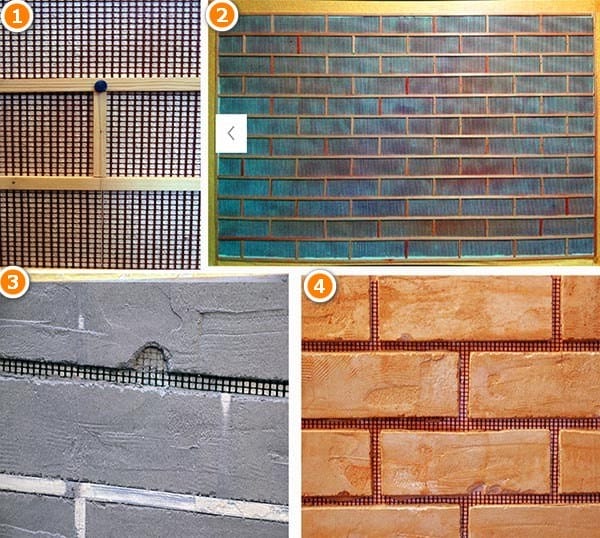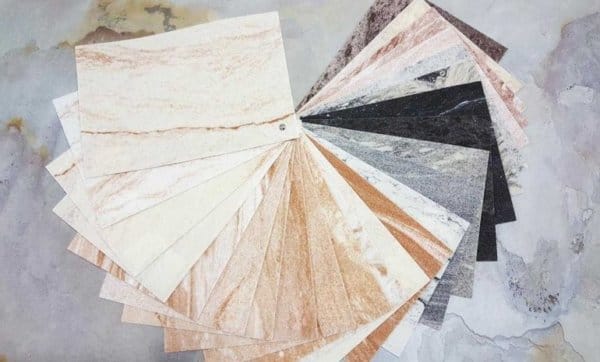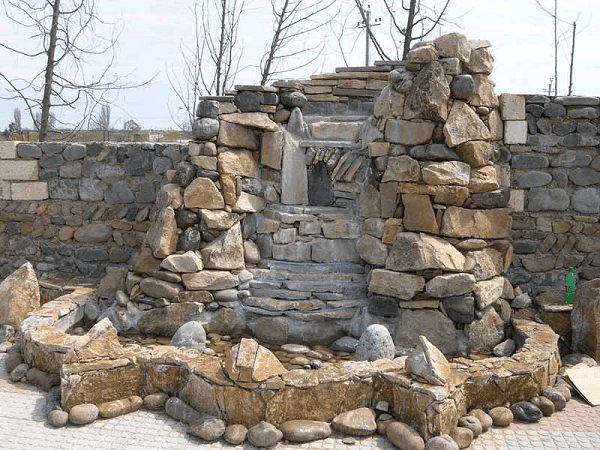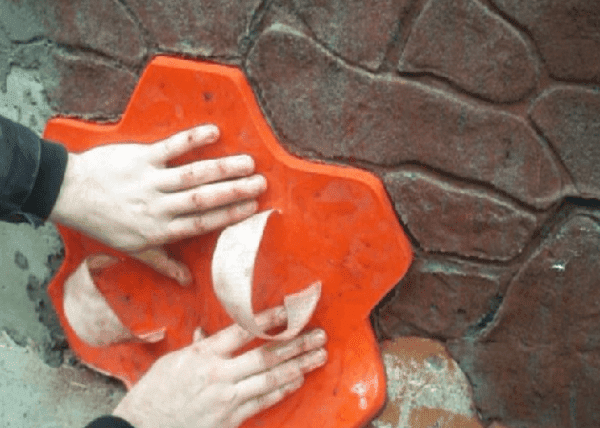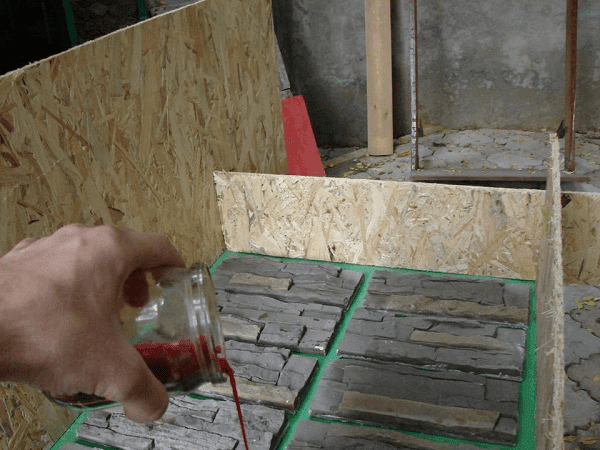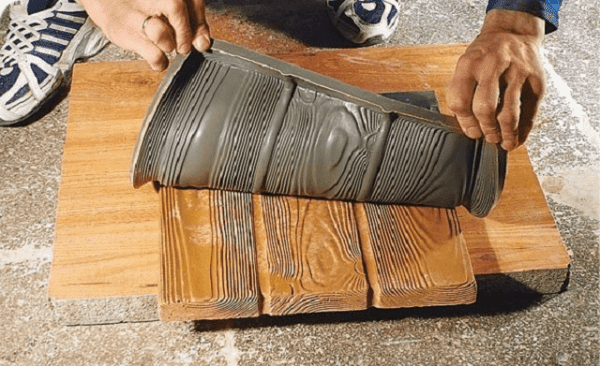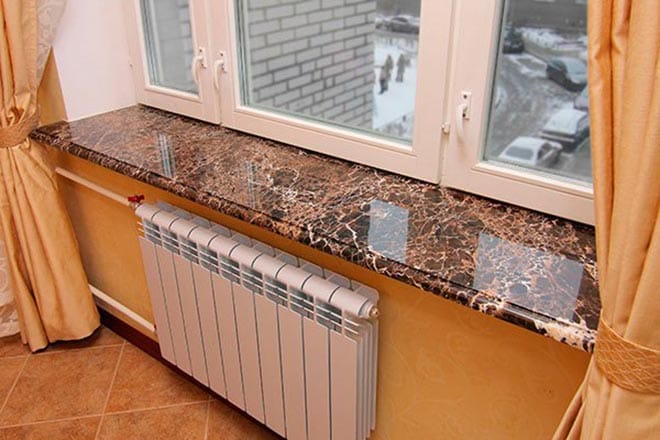What can be used to make decorative bricks?
The choice of material depends on where the artificial stone will be finished. For interiors, materials containing gypsum (alabaster, fillers) are suitable. Decorative bricks can also be made from concrete. Finishing materials for outdoor use (house foundations, walls or fences) are best made from a cement mixture.
The most suitable material for imitation of a stone is molding gypsum of the GF10 brand. This is a rather expensive material, but the bricks from it are strong and durable, it is easy to use and hardens in 10-20 minutes. At home, alabaster (gypsum grade G5) or a gypsum mixture for putty can serve as a substitute for it. The strength of products made from these materials is somewhat lower, but when you add glue for gypsum boards to the solution, you can get bricks of good quality.
In the manufacture of concrete tiles, only Portland cement of the M 500 grade should be used. And as a filler, use seeded river sand.
Types of artificial stone
Today, the types of artificial stone are countless. Such material can be intended for:
- interior decoration;
- exterior decoration;
- interior and furniture decor;
- creation and decoration of kitchen sinks, window sills, countertops.
Modern technologies make it possible to obtain an artificial stone that imitates even semiprecious minerals – tiger’s eye, moon, snake and cat stones, labradorite, serpentinite, pink eagle, etc. It turns out very beautiful. And most importantly, all this can be done by hand.
According to the source materials and methods of creation, artificial stone can be divided into:
- Ceramic, which must be fired at a certain temperature.
- Gypsum (molded or cast) for interior decoration, which can be made at home without much material and time costs.
- Reinforced concrete (monumental) free-form, made piece by piece directly at the finishing site. In this way, imitations of large boulders, cobblestones, etc. are performed.
- Hot curing polyester with mineral fillers, superior in technical and decorative characteristics to natural counterparts. True, it is unsuitable for home and small-scale production due to the solidification of the compound in a vacuum at an elevated temperature.
- Cold curing acrylic cast, excellent for home production. This material is thermoplastic and allows additional molding after casting.
- Liquid artificial stone created on the original gel coat and slightly inferior in quality to the cast. But this material can be easily made at home and used to create spatial compositions of complex shapes.
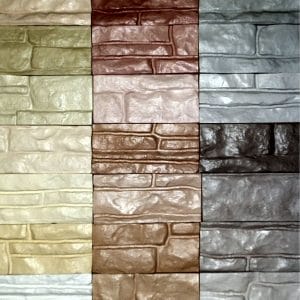
Acrylic stone
The main advantages of acrylic stone are resistance to chemical attack and the absence of pores, which during operation guarantees complete hygiene and compliance with sanitary rules. It turns out that such a stone can be washed / cleaned as much as necessary and by any means of household chemicals.
High decorative qualities of acrylic stone are provided by the optimal combination of its toughness and strength. For use on site, acrylic stone can be made in sheets 3-4 mm thick at least to the full height of the wall, and for transportation – with plates (6, 9 and 12 mm thick).
In addition, created on an acrylic binder, decorative artificial stone has an optimal ratio of thermal conductivity (low) and heat capacity (high enough). It is this feature that gives the feeling of “living” warmth when it comes into contact with the material, which is especially valuable in interior decoration.
Tile imitating brickwork
This tile is available in several versions:
- ceramic with a glazed surface that conveys well the texture and color of bricks, including old ones. Does not require subsequent surface treatment;
- gypsum, suggesting painting and / or varnishing;
- clinker. In fact, this is a completely real brick, but not made in the form of a parallelepiped, but in the form of a flat element. Surface finishing is optional.
All these varieties are often referred to collectively as “decorative brick”.
Laying any kind of it comes down to a similar list of works:
- wall preparation – leveling, strengthening if necessary. Permissible irregularities – no more than 1 mm per 20 … 30 cm, the same applies to the protrusions. You can read more about this in the article “Laying tiles
- laying tiles, and it is imperative to create intervals between rows and adjacent tiles – imitation of masonry must be reliable. To create even intervals, you can use special cross-dividers, which are used for mounting all types of tiles, or you can make your own dividers;
- grouting. Unlike conventional tiles, where the color of the grout is usually matched to the underlying cladding material, contrasting colors can – and often should – be used here. For more authenticity, cement gray tone. However, you can wipe the seams with an ordinary cement mixture, then the question of color will not arise at all.
Important points:
- before installation, it is necessary to mark the wall and prime it;
- laying is best done from the bottom up;
- imitation brick in the interior based on gypsum tiles must be protected. For protection, use any varnish intended for stone – transparent or tinted. It is applied with a dry brush after the installation is completed and the glue has completely dried.
Quartz Artificial Stone
Among the liquid artificial stone of hot hardening, quartz stone stands alone. It is created from ground vein quartz as a filler and polyester resin binder. In terms of durability and mechanical characteristics, this material surpasses the best stones of natural origin.
How to make from plaster or putty
Due to the fact that the thickness of the plaster layer is within 0.5-1.5 cm, the walls for its application must be properly leveled.
After leveling the wall, its surface must be primed, and only when it dries, you can proceed to applying plaster.
Slotting with a scraper
First, the solution is applied to the wall with a spatula. It is necessary to give some time for it to grab a little, and then with the help of a rule and a sharp plate they make seams. When creating a picture, it is necessary to observe the size of the brick and make a dressing, for this you can use a stencil.
After the seams have been drawn, the plaster is removed from them with a scraper. Seams can also be processed using such a tool as jointing, while both convex and concave seams are created.
First, horizontal seams are cut, and then vertical seams.
Making seams with tape
For this, not plaster is more often used, but putty. After the wall has been primed, seams are applied on it with a pencil and a ruler and glued with masking tape, while its ends must be taken outside the plastering area. You can fill the wooden slats with scotch tape.
After creating a pattern and drying the solution, the entire surface is painted, and then the seams are painted over separately. If the plaster is applied in a layer of 1 cm, then it will need 8-9 kg per square meter.
Craftsmen usually use gypsum plaster, it cannot be mixed with cement tile adhesive. These mixtures have different compositions and do not bond well together, which can subsequently lead to delamination from the wall.
Markup
How to make imitation of brickwork on the wall as natural as possible? There are two ways to create such masonry.
Individual elements
The size of the bricks is exactly the same – 250 mm x 60 mm. If you have a sheet of expanded polystyrene (polystyrene) in front of you, then the optimal width of one product is about 12 mm.
The material is easy to cut with a regular construction knife with a sharp blade. Moreover, each detail will have its own texture.
Sheet
Instead of individual bricks, you can make a decorative sheet that imitates masonry. Since the foam melts easily, a soldering iron is used for this. They are held at the seams, controlling the depth of pressing. Especially neat with the corners – they should be even, without rounding and bevels.
I must say, this method is suitable for those who are already familiar with the material; to do it perfectly the first time is unlikely to succeed. We need to practice.
When burning out, be sure to wear a mask, ventilate the room well! When melted, polystyrene emits harmful vapors.
Working with elastic clinker
- Very flexible material, fits on any surface, bends around even sharp corners.
- Easy to cut with long scissors, can be cut to any shape.
- UV and frost resistant, non-fading, breathable.
- Suitable for both interior decoration and house facades.
Surface preparation in this case is the same: it is leveled and primed. The difference is in the materials used. Most often, clinker is planted on tile adhesive, but the seller may advise you to purchase a special one from the manufacturer. Such a composition will make the tiles more stable and harder.
- First, the rows are marked with a simple pencil and ruler.
- The glue is applied with a notched trowel; a 2-3 mm layer is sufficient. It is not necessary to completely cover the entire area! Fill in small areas to prevent the adhesive from drying out.
- Apply the tiles gently without pressing hard. It is not difficult to make half a brick, just cut it with scissors.
- After the main stage is completed, the glue on the seams is leveled with a thin brush slightly moistened with water.
- Elastic clinker does not require grouting. This is the undoubted merit of the material.
Material advantages
What are the advantages of soft tiles for external and internal wall decoration with brick:
- versatility – the material is not affected by ultraviolet rays, as well as moisture;
- protection – in addition to the visual aesthetic effect, the tiles additionally protect the walls from external damage;
- insulation – when pasting a room, a soft layer is added, due to which small internal gaps are closed;
- durability – high strength guarantees the absence of chips, scratches, dents, and the material itself is resistant to mold, sun fading, drying;
- Convenience – when laying, the tile lays down evenly, does not wrinkle in the outer and inner corners, does not fill with air and folds.
Attention! The material is fire resistant, it does not ignite. In the event of a fire, the surface melts and immediately dies out.
This quality is important for interior and exterior decoration. In the event of an unexpected appearance of fire, the walls will not burn.
Flexible
It is a roll material coated with natural stone chips. It is especially convenient to apply on surfaces with complex geometries, corners and other areas inconvenient for finishing with conventional board materials (how to veneer a corner with decorative stone?). For manufacturing you will need:
- reinforced fabric base or fiberglass canvas;
- polymer binders (silicone-acrylic or pure acrylic glue);
- dust or chips of natural stone (sandstone is more often used).
To obtain an even layer of cladding, it is necessary to evenly pour stone chips or dust on the surface of the glue and press with a strong plate after application.
Features of PVC and MDP panels
How volumetric panels differ from other materials:
- strength and stability – the material is not affected by the external environment;
- replacement of parts – in case of mechanical damage, the panel changes without disrupting the overall structure;
- sound insulation – PVC and MDP absorb noise;
- disguise – with the help of panels they hide pipes, wires, errors on the walls.
Attention! PVC and MDP panels do not require preliminary wall preparation. To install them, it is not necessary to make the surface perfectly flat.
More “sophisticated” options for such panels are models with foam and mineral wool. They are used for facing cold balconies for the purpose of insulation.
What is needed for finishing
In addition to the softest tiles, the following elements will be needed to decorate a brick wall:
- primer;
- two spatulas;
- universal glue;
- brush;
- building level;
- cord for marking.
Advice! Before buying a tile, you need to measure the wall area. A hardware store consultant will help you determine the amount of purchased material.
On request, you can also purchase a ready-made mixture for laying tiles, instead of dry ingredients. However, manual cooking allows you to select the desired consistency.
It’s important to know! When buying a flat trowel, you need to pay attention to the width (15-20 cm), and for a notched trowel, the size of the grooves should be 4-8 mm. This is important for even distribution of the material.
You also need to know the size of the brush and the building level. The first element will be needed to process the seams, so a centimeter width is optimal, and the second should correspond to a long one and a half meter ruler.
Advantages and disadvantages of the material
The quality and safety of the artificial stone are at a high level. But still, the material is inferior to natural minerals.
Advantages and disadvantages of materials for artificial stones:
|
View |
pros |
Minuses |
| Acrylic | Repairable, does not absorb water and dirt, wear-resistant, does not burn | There are traces of a red-hot object, damaged by a knife |
| Quartz | Resistant to household chemicals, hot objects, mechanical damage | Heavy, more expensive than natural quartz, there is no possibility of repairing and hiding the joints |
| Cement | Durable, fireproof, resistant to moisture, frost and mold, washable with household chemicals, repaired | Heavy |
| Gypsum | Lightweight, insulate heat, sound, repairable | Pulls moisture, mold formation is possible, the solution sets quickly |
| Flexible | It is mounted on the surface of any structure, it is vapor-permeable, it is well mounted, the seams are easily hidden, it is repaired | Dear |
All materials allow you to make a thing of any shape and size. In some cases, it is impossible to separate disadvantages from advantages.
Adhesives do not impair the environmental friendliness and beauty of artificial stones, but they also hide the natural mineral with a film. As a result, the texture of the rock is not felt, but the resistance to damage is improved.
Design Tips
The more light hits the brick wall, the more natural and natural it should look. A backlit decorative brick wall attracts attention, and if it is done inaccurately or of poor quality, it makes the interior cheaper.
Choose a color based on the overall color scheme of the room. Standard terracotta is suitable for warm interiors, cold gray for more brutal ones. By the way, it is better to add a little ocher to neutral white, so it will not seem flat and lifeless.
How to stack correctly
The choice of the method of fixing panels for brick wall decoration depends on the surface. If the wall has irregularities or it is necessary to mask pipes and other details, a special subsystem will be needed. It consists of additional metal strips that form a frame. You can also use wooden beams.
Advice! To mask errors on the wall, it is better to give preference to panels with ready-made frames and hooks from one manufacturer. This will facilitate the wall mounting process.
If the wall is flat, then the material can be glued with liquid nails. For heavy blocks, cement masses, screws or self-tapping screws are used. Panels are laid depending on the direction of the brick pattern.
Making a mold for casting brick tiles from gypsum
Another imitation of brick for interior decoration in an apartment or house can be cast: you can make gypsum tiles yourself in the form of bricks. To do this, an impression is removed from interesting specimens of bricks (a mold is made to form an artificial finishing stone), then plaster mortar is poured into it. The resulting tile is used for wall decoration. This technology is good because it allows you to prepare several shapes in which you can make bricks of different colors for different rooms.
We find bricks interesting in shape and a few almost ordinary ones, but with various small defects. We will use them for casting the mold. It is desirable that there are at least a dozen of them, and better – more. The “artificial brickwork” will be more varied.
The result can be very similar to real masonry
On the side to be “multiplied”, we apply grease or heated wax mixed with kerosene. This is necessary to prevent the silicone from sticking to the surface. When everything dries up, apply a layer of silicone sealant to the treated side. The layer thickness is 1-1.5 cm. We leave until the silicone is completely polymerized (the time depends on the type, it is written on the package).
You can also make the following forms: imitation of bricks with marine motives
When the silicone has hardened, we take the polyurethane foam and coat the mold without removing it from the brick. After the foam hardens, remove the brick, level the bottom of the mold so that it stands level. Can be used by filling with plaster mortar. It quickly sets, if you have a dozen forms in 2-3 days, you can make a tile for a couple of squares imitating a brick wall. By the way, gypsum solution can be painted in bulk. Then new cracks and chips do not matter – like a brick.
Painting and decor
Some leave the texture of the foam, while others cover it with putty – to give a special structure to the stone.
In any case, the material must be primed before painting. Choose paint carefully, it can ruin the expanded polystyrene. Solvent-free paints, such as water-based paints, are suitable. The result can be fixed with matt acrylic varnish.
How to mount on a wall
After purchasing soft tiles, you need to remove the material from the packaging and cut with scissors at the designated places. Next, mix the bricks.
Attention! The color of the soft tiles will not be uniform. The manufacturer uses several similar shades to achieve maximum similarity with a real brick wall. Therefore, it is important to mix the parts well.
The process of laying soft tiles on a wall consists of 5 steps:
- step 1 – cleaning the wall from the previous coating, grinding, leveling the surface;
- step 2 – treatment with a primer for further protection against mold and mildew, as well as for better adhesion of the tile to the wall;
- step 3 – outlining the extreme rows, marking;
- step 4 – surface treatment with glue and leveling of the coating with a notched trowel;
- step 5 – laying out soft tiles.
Advice! Laying bricks should be started from the bottom row and move gradually up the rows. It is also necessary to alternate whole tiles with halves – for example, if at the beginning of the first line there is a whole brick, then the second should be laid out in half.
To make the seams neat, you need to make them approximately the same. After laying it out, it is also important to soak the brush in water and walk it between the rows.
Installation of PVC and other polymer panels
Everything is simple here: you should follow the manufacturer’s instructions. Of course, the wall in advance does not interfere with leveling, filling and priming – this will facilitate the creation of a flat surface.
Panels are usually offered in the form of flat rectangular products that are easy to fit, or in the form of models with a “broken” edge – protruding “bricks”.
Accordingly, they are glued to the aligned wall, aligning the edges so that the order of the “masonry rows” is not disturbed.
Manufacturers recommend fixing hard and heavy panels with self-tapping screws, lighter ones – just with glue.
The places where the screws are installed are then masked with grout, as are the joints between individual panels.
Panels are also available that are attached to the upper edge, made in the form of a metal strip with holes. Subsequently, this tape is masked by a cornice strip.
The main types of stone
By application, there are products for indoor and outdoor work, as well as decorative items. The types of artificial rocks are distinguished by the type of mineral filler.
Crumbs and / or powder are used from natural materials:
- limestone
- granite
- marble
- sandstone
- slate
- basalt
- tufa
- porphyry;
- talc magnesite;
- other stones.
The types of artificial rocks are also distinguished by their binding components. Imitation stones are made from epoxy resin, polyester mixture, cement, gypsum, sand.
Cement based
Made by casting. The imitation is made from a mixture of cement and sand (3: 1). In the process, no natural stone is used at all. Naturalness gives relief to the shape and the correct selection of dyes.
For the strength of the concrete material, add:
- reinforcing net or fiber;
- plasticizer;
- water repellents.
At the exit, the products are heavy. Therefore, in the manufacturing process, a grid is drawn on the back side. This improves the adhesion of the slab to the mortar and work surface. They also buy glue for the installation of concrete structures.
Video on how to make a coating:
Gypsum based
They are made by casting in the same way as cement products. But for imitation, an aqueous solution of gypsum powder is used. There are ready-made gypsum mixtures on the market for the production of artificial stone with improved physical and mechanical properties.
Moisture resistance is increased by adding:
- asbestos;
- white cement;
- fine-grained sand.
Slaked lime is introduced to prevent the appearance of mold. When mixing the solution, emulsion or acrylic paint is included in the composition. But this is not necessary: the finished tiles can be painted after installation.
To view the production of a stone that imitates slate:
Equipment and materials
To make a cast artificial stone at home, you will need quite specific materials, tools and equipment:
- shaker (first of all);
- ready-made molds for casting or models for their manufacture;
- release agent, which is used to cover the molds before casting the stone and the model before making the molds, so that nothing sticks to anything;
- compounds or foundry mixtures;
- pigments;
- thermal gun for welding and forming elements of acrylic stone.
You may also need a sandy cushion tray for silicone homemade molds.
DIY styrofoam brick
Expanded polystyrene is a type of polystyrene foam. The material can be used for brick decor, but for this you need to cut it yourself into tiles of the appropriate size, paint it with paint and open it with varnish.
Attention! In order for the expanded polystyrene bricks to look realistic, they must be melted with fire. The procedure is done outdoors using a respirator, as the material releases toxins when melted.
The procedure for pasting a flat wall under a polystyrene foam brick is carried out using liquid nails, similar to the fastening of panels. If there are errors on the surface, they need to be corrected. Before applying the glue, it is advisable to treat the wall with a primer for greater tenacity.
How to make a pouring mold
The quality of the surface and the strength of the artificial stone depend on how correctly the design and material of the form are selected. It is quite easy to make the right choice if you take into account the properties of the material from which the fill will be made.
Most often, the following are used to form the casting:
- Silicone or latex molds, which have high elasticity and mobility, are easy to separate from the hardened mass of concrete and gypsum, but are practically unsuitable for working with stone and polymer resin blocks;
- Polyurethane casting blocks that are tough and strong enough to allow normal curing of large stones such as concrete, cobblestones and even paving slabs;
![Do-it-yourself imitation of brickwork. We make an artificial stone with our own hands]()
- Wooden molds are suitable for the mass production of massive artificial stone, for example, facing stone or material for finishing the basement of the walls. Currently, it is not used as an independent casting device, most often a wooden structure serves as a frame for a latex, silicone or polyurethane liner.
All three types of forms are used as equipment for small-scale and mass production of artificial stone for finishing needs. For one-off production, wax-paraffin forms are used, for example, if you need to make a polymer-granite countertop with your own hands or an imitation of a stone array for arranging a window sill.
If it is necessary to make an artificial facing stone with a thin mesh pattern or interspersed with precious metal, metal casting dies are used. This design allows you to reproduce graphics of almost any complexity on polished stone, up to inscriptions or brand names.
Tiles made of polymer granite with an imprint of the brand are widely used for cladding bathrooms and baths to emphasize the quality of the materials used.
Form requirements
Making a mold for the manufacture of high-quality facing stone is not as easy as it might seem at first glance. The casting matrix, into which the mixture will be poured, must have a certain rigidity and not deform under load. Most silicone or styrene-butylene dies and molds will only withstand the pressure of relatively thin tiles. In this case, the form must be in a horizontal position. If you pour an artificial stone into a vertically standing form, the so-called duplex, then deformations of the material pattern will inevitably appear. Even a frame or a sand cushion does not help.
In addition, the mold material must not absorb water, binder or react with additives such as alkalis or citric acid. If a vibrating table is used in the production of artificial stone tiles, then the form must be made collapsible, in other cases a monolithic silicone matrix is best suited.
It is recommended to make a mold for casting an artificial stone with an intermediate varnishing of the surface, this somewhat complicates the separation, but ensures an almost glossy quality of the facing tile. For a torn texture, silicone or polyurethane, on the contrary, is grained with sand to emphasize the fracture of the stone.
Wooden forms
Casting boxes and molds made of thick plywood are most often used for two types of artificial stone castings:
- If it is necessary to make a volumetric casting;
- In the manufacture of countertops, stone shelves and window sills with the most flat and even stone surface.
For your information! Waterproof bakelite plywood with a laminated surface is better suited. Flat and box structures are also used for stacking full-size volumetric forms.
For example, in the manufacture of details of stucco or bas-relief, small figurines, elements of monuments made of artificial marble, a split silicone model or a wax mold with a clay coating is used. The mold is placed in a wooden box and covered with sand, after which the wax is melted, and the space is filled with a stone mixture.
If you find several fragments from foam insulation boards at hand, then it is quite possible to make a wooden form for casting an artificial stone without any silicone or other polymer resins. To form the broken texture of the chipped stone, the edges are cut and folded in a bag so that the foam matrix does not fall apart, the set is pierced along the edges with nails.
The resulting workpiece is coated with acrylic varnish and dried, then a casting box must be made from a wooden board or plank according to the size of the foam matrix. The imprint is installed instead of the bottom of the box and covered with several strips. The finished form is painted with waterproof paint and poured with a mixture.
In the simplest version, you can make a form – a stamp for casting facing tiles made of artificial stone with wood-like embossing from several wooden planks selected according to the texture and pattern.
Silicone forms
If you want to finish the corner of the basement of the house with a small tape of artificial stone tiles, then there is no point in acquiring an expensive polyurethane form, it is easier and faster to make a casting matrix for several dozen tiles with your own hands.
To form a matrix, you need to make a box of OSB, plywood or even cardboard glued with tape. The height of the box is 60-65 mm, the dimensions are usually limited to 60×70 cm. This is enough to cast 4-5 artificial stone tiles. The larger the mold, the more silicone and time it takes to make it.
The original model of the future stone surface is placed on the bottom of the box. It can be broken foam, wood, brick, ceramic tiles or a very beautiful and effective multi-layer impression “Leon”,
This texture can be made from several layers of plastic or plywood folded in a bag. Any version of the matrix, regardless of what material it was made of, is coated with oil or alkyd varnish and dried thoroughly. If the base is made of polystyrene, then drying oil or heat-treated “boiled” oil varnish is used as a protective coating.
The mold material is a one-component, low polymerization acrylate silicone. Sold in tubes, polymer sausages and plastic buckets, it looks like an old thickened CMC glue. It is easily recognizable by its vinegar smell. It does not conduct water, and it passes water vapor very well. This is its most important characteristic.
You can, of course, make a mold for a concrete artificial stone from a denser and harder two-component silicone, in the hope that the silicone matrix will be enough for a couple of hundred castings instead of the required three dozen. But a problem arises, if you pour a cement-sand mixture into dense silicone, then it will harden for at least 4 days before the form can be removed.
The matrix and the walls are lubricated with technical petroleum jelly, after which the space is squeezed out or covered with a silicone mass. To make a shape, a dense silicone mass is pressed into the matrix with a spatula moistened with soapy water.
If it is necessary to make a silicone mold for an artificial stone based on a polymer resin, then the silicone is heated and, if possible, dried. In industrial and laboratory conditions, the silicone mass under an artificial stone is subjected to evacuation, as in the video
Polyurethane molds
The silicone mold is enough for 30-40 artificial stone castings. In practice, even small works on finishing the facade require at least one and a half to two hundred tiles only for the basement adjacent to the entrance group of the building.
If you need to make a mold for the manufacture of artificial stone for sale, then it is best to use cast polyurethane resin with chemical curing to form the matrix. Silagerm No. 5035, specially designed for the production of impressions, dies and injection molds, is now available on our market.
Before pouring, the surface of the matrix is covered with a separating layer of silicone or more viscous Tiprom 90. After mixing with the hardener, it is necessary to fill it with polyurethane resin within an hour, the final form is ready after 24 hours.
For especially complex shapes for pouring artificial stone mass, you can use Poly 74-29 molding polymer, made in Germany. A fairly expensive material has a very low viscosity, so the shape can be made for a matrix with the most complex surface. True, the cracks and joints will first have to be sealed with mastic or covered with plasticine.
After mixing with a hardener, the polyurethane mass acquires a yellow color and the consistency of a very liquid sour cream. The mixture is allowed to stand for 10-15 minutes to remove air and is poured into the mold in a thin stream.
The material of the polyurethane compound will need to be smoothed with a spatula or sharp object for 10-15 minutes to facilitate the removal of air bubbles. After a day, the poured form can be carefully removed from the matrix.
Recommendations for the use of brickwork in the interior
A brick wall can look very different: it can be neat and smooth, with even seams and a solid surface, or intentionally sloppy and rough, with potholes, scratches and plaster remnants. It all depends on the chosen style and the method of creating such a wall. Therefore, the entire environment must correspond to it, otherwise the brick will look alien and create the impression of uncomfortableness and eternal repair.
Interior designers advise not to get carried away with this technique and heed the following recommendations before making a brick wall:
-
if your goal is not to create a bright loft interior or imitate the hall of an ancient castle, then you should not decorate all the walls in this way. It is enough to arrange only one of them or even a part of it under a brick, thereby creating an accent that attracts attention;
-
a brick of a natural shade absorbs a lot of light, this must be taken into account when decorating small and poorly sunlit rooms;
-
this finish goes well with smooth painted walls, textured decorative plaster, wood. Bad – with ceramic tiles, artificial stone, plastic panels;
-
masonry itself is a striking design element, so you should not load such a wall with paintings, posters or framed photographs. An exception is made only for light monochromatic surfaces. The same applies to the filling of racks and shelves on a brick wall: it must be uniform in texture and color;
if such a wall still turned out to be too oppressive and cumbersome, mirrors can be hung on it, in which quieter opposite surfaces will be reflected.
Artificial stone making
In factories, they are made using automatic equipment. In the course of work, vacuum, high temperature, dryers are used.
For home production they buy:
- Silicone forms;
- wax or other means to facilitate separation of the mold from the finished product;
- vibration table;
- sieve;
- mixers;
- containers for solutions;
- knives or equipment than cutting parts;
- grinding tools;
- drying rack.
For personal protection, they buy a respirator, gloves. You need running water, soap or a special agent to wash the polymer off the skin.
Artificial stone components:
- mineral filler (stone chips, powder) or sand + cement, gypsum;
- acrylic or epoxy resin;
- a set of dyes (powder or liquid);
- thermal gun.
First, dry components are mixed. Make a slurry by adding water or resin, dye. The form is lubricated with a separating agent, the finished liquid is poured. Vibration removes air from the solution. Leave to harden, then dry without a mold.
Fill
During the molding process, the shaker must be turned off.
There are two stages in casting – start and base stages. For the sake of economy, appropriate mixtures are prepared. The starting (front) mixture is liquid, the base mixture is thicker, according to the above proportions (in the section Casting mixtures).
When filling simple flat forms, the face (liquid) composition must be applied.
For forms with relief, the facial composition is first applied with a brush. It perfectly envelops the surface of the mold. After it has hardened, the base composition is topped up.
Casting plaster
The starting composition is liquid. Basic – sour cream condition. As soon as the mortar begins to set, it will be necessary to draw grooves. This is important for the subsequent attachment of gypsum stone to any surface. After the gypsum stone is ready and you take it out of the mold, do not forget to treat it with heated vegetable oil (for this, heat it up in a water bath). This will close the pores and increase the wear resistance of the stone.
Pouring concrete
Cement-sand composition for concrete is diluted liquid. After hardening, add the base composition using the following technology:
- The form is half filled. A reinforcing plastic mesh is laid down, it does not reach the edges of the form;
- The form is filled to the brim and leveled with a spatula.
When the grout begins to harden, remember to draw the grooves.
Pouring acrylic stone
In the face (starter) composition, the part of the resin with the hardener increases, and the percentage of the filler with the pigment decreases to 50-60%. The result is a more fluid mixture that is easy to apply to the mold. After it hardens, the base composition is added to the mold. It uses microcalcite as a filler (without pigment). It allows you to convey all the beauty of the facial composition.
To level the acrylic after pouring, you will need a trowel, preferably polished metal. It must be fat-free. As soon as the acrylic hardens, we make grooves in it.
Pouring liquid stone
LCD can be applied to a product in two ways:
- Spraying is cheaper, because a layer of several millimeters is applied. You will need a compressor and a spray bottle.
- Direct or reverse enveloping.
Envelope:
- Direct application: the base made of MDF, wood, fiberboard or chipboard is first primed, layer thickness 3-4 mm. Next, the base is covered with a facial compound. The disadvantage of this method of making an artificial stone is the roughness of the surface (the degree of roughness depends on the size of the filler fraction). For further use, the product will have to be additionally grinded and polished.
- Reverse application: You will need a matrix with a crystal flat surface. A separator is applied to it, followed by a compound. A board is superimposed on top and everything is pressed down by weights. This is how countertops are made. This method does not require additional grinding, because a smooth surface is obtained.
How to make imitation bricks from scrap materials
As already indicated in the table, a wide variety of materials are used to create the appearance of brickwork – from cardboard and drywall to foam. The general procedure is as follows:
-
a suitable sheet material is selected (thin foam, polyurethane foam, cardboard, drywall), cut into rectangular fragments of the same or different (depending on the chosen masonry pattern) size. For convenience, this is best done using a template;
-
the surface of the fragments is given the texture of a brick. This can be done with plaster, various mixtures based on gypsum, cement, even with crumpled paper napkins. Here, those who want to try their hand should better turn to the technique of imitation of decorative plaster – there are a lot of lessons on creating a relief surface on smooth panels. Further prepared “bricks” can be immediately painted in the desired color, while not necessarily all in one. It is interesting that for foam and other soft materials, the relief can be made by scratching, deforming the surface;
-
the wall is marked under the “masonry” pattern, primed and, if necessary, painted. This should be done if you want to get the same color for all “joints between bricks”;
-
the last stage is gluing the prepared elements (for example, imitation of drywall bricks) on the wall according to the markings. If desired, the resulting surface can be opened with acrylic varnish for safety and ease of cleaning.
A short video tutorial on creating a “brick wall” from cardboard will allow you to better imagine the possibilities of this original technique “out of nothing”.
And here is the technology for making “bricks” from drywall.
By the way, the author of the video has a continuation of the master class – on creating a grout for seams and painting decorative cladding.
There is another interesting way to create brick-like facing tiles from waste – paper egg trays. They are mounted on the wall in the same way as other types of imitation.
How do ingredients affect quality?
Many are convinced that the structure and composition of the artificial finish affects the performance of the material. This statement is erroneous as strength depends on adherence to recommended manufacturing techniques, not on the components used. Particles of sand, foamed glass, expanded clay balls, marble chips and other additives in a ratio that does not exceed the norm do not make the material less durable.
Similarly, the type of surface – smooth or embossed – does not affect. In this case, it is worth treating it to increase the service life with water repellents. Then this material will not be afraid of moisture and other adverse atmospheric influences. The quality of the decorative stone determines its resistance to fracture. If the tile crumbles easily, then the material is of poor quality, and paint and varnish coatings or other methods of influencing the durability of the finish will not bring results.
For cladding, decorative stone is often used, which is of natural or artificial origin. It is a durable material that provides reliable protection to load-bearing structures. Artificial stone has less strength and durability than natural stone, but at the same time it has a lot of other advantages – a variety of colors, shapes and types of finishing elements, ease of installation.
Vibration stand
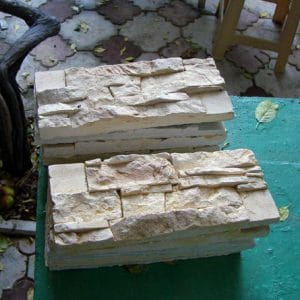 A vibrating table is a structure that ensures the hardening of an artificial stone with the proper homogeneity of the mixture for its production. You can even make such a stand yourself.
A vibrating table is a structure that ensures the hardening of an artificial stone with the proper homogeneity of the mixture for its production. You can even make such a stand yourself.
Any low-power electric motors are used as vibrators (the total should be about 30-50 W per sq m). There should be at least 2 of these motors in the corners of the platform, and ideally – 4. If you have to use only one motor, it is better to place it in the center of the installation platform, and then the pallets with forms should be installed at the edges.
To regulate the strength of vibration, the motors are powered through a rheostat or thyristor regulator.
Eccentrics are mounted on the motor shafts – you can use point ones, or you can use U-shaped pieces of a bar or strip tightened with screws. The rotation speed of the motors should be 600-3000 rpm. If it is less, the mixture will stratify, and more – the required vibration force will not work.
The platform is made of dense but laminated material (thickness 8-20 mm). Plywood, getinax or fiberglass are well suited. Layering is the most important factor in the selection, since mechanical vibrations along the platform should propagate quite freely along the horizontal platform and quickly decay vertically.
The pallets with the working composition are fixed on the platform using self-tapping screws.
As for the springs on which the platform vibrates, they must be equally stiff. Loaded, under the weight of the platform, such springs should be compressed by no more than a fifth of their length. They must be taken linear (cylindrical, made of wire of uniform cross-section), wide. The installation step is 300-600 mm both along the length of the platform and along its width. That is, there should be 9 such springs on each square meter of the platform. In the platform and the base of the stand, special holes or annular grooves are made for the ends of the springs so that the platform does not slip during operation.
In this case, padding blocks made of foam rubber in contact with the springs serve as absorbers of parasitic overtones. Under the weight of an empty platform, such blocks should be compressed by a third.
It is better to make the base of the stand wooden – it will also extinguish the overtones, while the metal base will also start ringing them.
On a rigid support, the shaker is installed on adjusting screws that allow the platform to be aligned strictly horizontally.
Surface care
If the imitation brick made of plaster is not painted or opened with varnish, during operation it should be looked after in the same way as for ordinary decorative plaster with a pronounced relief. Such maintenance consists of periodically removing dust with a vacuum cleaner or soft brush.
The lacquered surface can be simply washed using mild (not abrasive!) Detergents and cleaners.
Important: the steam generator must not be used for cleaning! All work will go down the drain.
Decorative stone casting technology
Before you start casting decorative bricks with your own hands, you need to prepare everything that is needed in the work. Required materials may include:
- polyurethane mold for making gypsum bricks;
- gypsum brand GF5 or other;
- cement and sand;
- container for mixing the solution;
- drill with attachment;
- dyes.
To give strength to products made of stucco or putty, it is best to purchase gypsum assembly glue (Knauf Perlfix or other).
The solution is prepared from 2 parts of alabaster or building gypsum (G4, G5) and 1 part of assembly glue. The components must be mixed well in dry form, and then pour the mixture into water, taken in a proportion of 1 liter per 700 g of gypsum components.
The composition of the molding plaster solution is as follows:
- dry gypsum brand G10, GF10 – 6 parts;
- slaked lime – 1 part.
Water for the solution should be taken 1 liter for every 700 g of gypsum used to prepare the solution. For gypsum-based solutions, you need to prepare only a portion sufficient for 1 pour.
Concrete for making bricks is prepared from 3 parts of cement and 1 part of sand. To give greater strength, you can use polymer additives according to the manufacturer’s instructions or PVA glue at the rate of 200 g per 10 liters of solution.
Place silicone molds (or any others) on a leveled surface. Pour the ready-made solution and give it time to harden. Remove the finished tile from the mold and apply acrylic dyes to it. To imitate brick, ocher or umber are suitable, natural stone can be painted, focusing on its natural color. To decorate a room or the exterior of a house, lay imitation bricks on a layer of tile glue. After installation, fill the joints with grout (colored or white), remove its excess from the stone surface
Stand adjustment
To adjust the shaker, you must:
- load it completely (put a pallet with filled forms and secure);
- for weight, put models in the forms;
- level the base and platforms on it with a bubble level;
- set this very horizontal position with the adjusting screws;
- put directly on the molds a saucer with a ball from the bearing (diameter 5-6 mm);
- bring the vibrator regulator to a minimum;
- turn on vibrators;
- smoothly add power, making the ball bounce on the saucer;
- then gradually reduce the power so that the ball rolls over the saucer again, ringing.
Conclusion
Of all these methods, undoubtedly the most budgetary – and giving the greatest scope for imagination – are homemade options for “brickwork” from plaster or scrap materials. However, one should not expect high strength and durability from such a cladding.
The most expensive and durable option is considered to be a high-quality brick-like ceramic tile, moreover, laid by a master tiler. The difference in price (taking into account the cost of work) is up to 3 … 5 times.
Sources used and useful links on the topic: https://kubkirpich.ru/o-kirpiche/kak-v-domashnix-usloviyax-sdelat-dekorativnyj-kamen-ili-kirpich.html https://okeymaster.ru/iskusstvennyy-kamen -samostoyateln / https://stroy-okey.ru/remont/walls/imitacija-kirpicha-dlja-vnutrennej-otdelki-svoimi-rukami/ https://dom-s-ymom.org/stroitelstvo/konstruktivnye-resheniya/steny /kirpichnaya/imitaciya-svoimi-rukami.html https://www.ivd.ru/stroitelstvo-i-remont/steny/imitaciya-kirpichnoj-steny-svoimi-rukami-3-prostyh-sposoba-43661 https: // m -strana.ru/articles/imitatsiya-kirpicha/ https://okcomfort.com/steny/decorativnii-kamen/sostav.html https://zakamnem.ru/vidy/iskusstvennyj-kamen https://stroychik.ru/steny / imitaciya-kirpichnoj-kladki https://rusolymp.ru/raznoe/iskusstvennyj-kamen-svoimi-rukami-v-domashnih-usloviyah https://m-strana.ru/articles/kak-sdelat-kirpichnuyu-stenu-v-interere-svoimi-rukami / https://kamendek.ru/kamen-dlya-otdelki/ik/iskusstvennyj-kamen-svoimi-rukami

